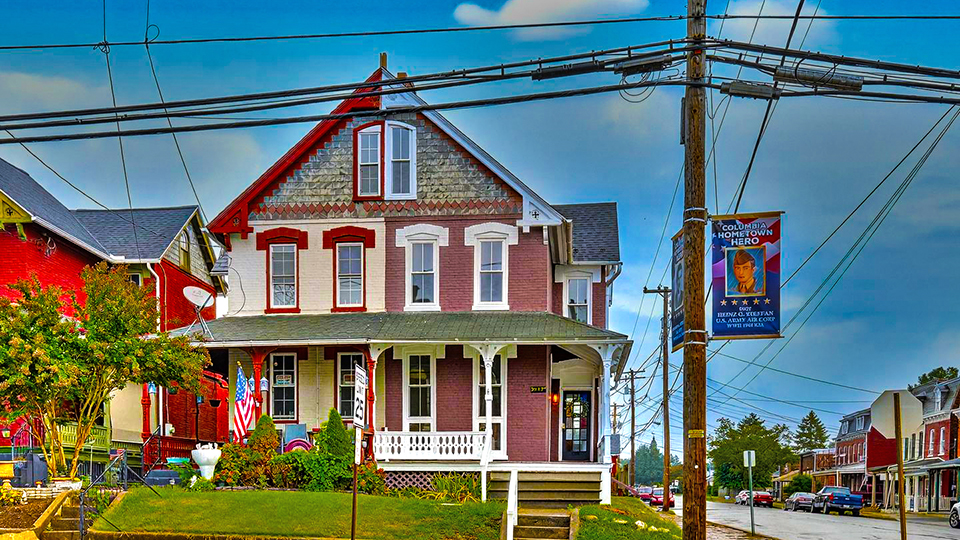

Columbia Borough Hall is located at 308 Locust Street, Columbia PA 17512.
Phone: 717‑684‑2467.


Columbia's initial settlement dates to 1725 when Dr. John Taylor, Chester County surveyor, surveyed a plot of ground located at the site of the Shawanah Indian town. Early landowners included John Wright and his daughter Susanna, Robert Barber and Samuel Blunston all influential Quakers with strong ties to the proprietary government. Their move westward was backed by a government anxious to blunt the unauthorized settlement of the Susquehanna Valley by the Scotch-Irish. Samuel Blunston had authority to issue emigration tickets to Germans willing to settle on the western side of the river and improve the land. Blunston laid out the town of Hellam in York County for the same purpose.
In 1730, John Wright secured a patent for the ferry. Crossings began and increased once the road linking the ferry to Lancaster was completed in 1734. In 1739 a public road was laid out from the ferry 34 miles to connect with the Monocacy Road in Maryland and from there to the Potomac at the base of the great Virginia Valley which constituted an important open road between the colonies. Wright's Ferry held a commanding position on that thoroughfare. By 1780 business was so heavy that a wait of 2-3 days to cross was not uncommon. A brisk tavern and hostelry business eventually established itself to accommodate the travellers' needs. In sum, the ferry remained a key gateway to the west for almost 100 years, until the first bridge across the river was built at Columbia in 1814.
In 1797 a canal was completed which facilitated travel around the falls and shallows of the Susquehanna above Columbia. Another set of falls below made travel on the lower Susquehanna difficult. Columbia also connected with the Susquehanna Turnpike heading towards the Philadelphia market and the passage west into the great valley. Consequently, Columbia developed into a transshipment hub. In the spring immense quantities of flour grain, whiskey and lumber were channeled down the river from northern and central Pennsylvania as well as southern New York bound for Philadelphia or Baltimore. Arks, keelboats and rafts careened down the freshet waters. At Columbia, their cargos were taken off to be milled or repackaged for shipment elsewhere. The rafts were torn apart, their lumber stacked in huge mounds along the riverfront to air dry and season. Eventually wharves and sawmills were erected, making the town a premier lumber mart.
In the early part of the 19th century considerable attention was given to internal improvements, especially at or near Columbia. The governments of both Pennsylvania and Maryland formulated schemes to gain load of goods produced within the Susquehanna Valley. The river was improved on both sides by canals. The Pennsylvania Canal which terminated at Columbia on the eastern bank of the river was completed in December, 1830. The Maryland chartered Susquehanna Canal Company dug a canal south along the western side of the river from Wrightsville to tidewater at Havre de Grace which was opened in 1835. About the same time the canals were finished, the Philadelphia and Columbia Railroad was completed. This was Philadelphia's answer to Baltimore's challenge. The railroad proved to be a great advantage for shipping but was not a source of great profit to the state and in the mid 1850's the Pennsylvania Railroad purchased and improved it. By 1860 Columbia was connected by rail with Baltimore, Philadelphia, Reading, Harrisburg and the west.
During the remainder of the 19th century, particularly during a boom following the Civil War, the town bustled with activity and gradually filled in its vacant lots with a wide variety of residences and a bustling commercial center. Planning mills, foundries, machine shops, flour mills, engine manufactories and cigar making establishments sprang up to take advantage of Columbia's position. Iron manufactory was begun in 1844 when the Shawnee Furnace, was erected, and several others followed. Following a depression in the iron industry, in the 1880's, new businesses were courted for Columbia by an active board of trade. Attracted by Columbia's transportation advantages and incentives such as cheap land and tax exemptions, lace, silk and knitting mills were established.
‡ Morse, Rollin D., Columbia Historic District, nomination document, 1982, National Park Service, National Register of Historic Places, Washington, D.C.
Nearby Towns: East Prospect Boro • Lower Windsor Twp • Manor Twp • Marietta Boro • Mount Joy Boro • Mountville Boro • Wrightsville Boro • Yorkana Boro •